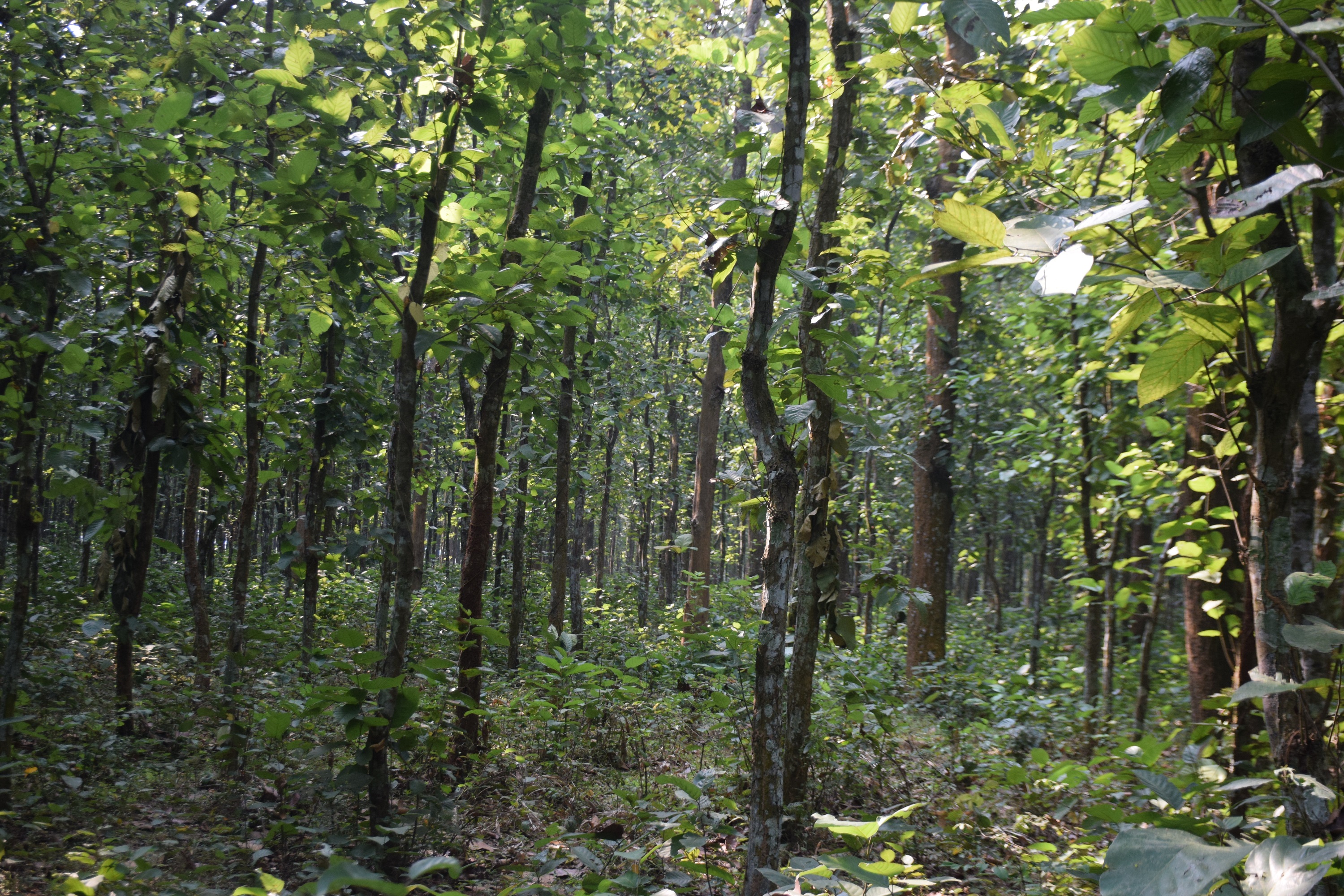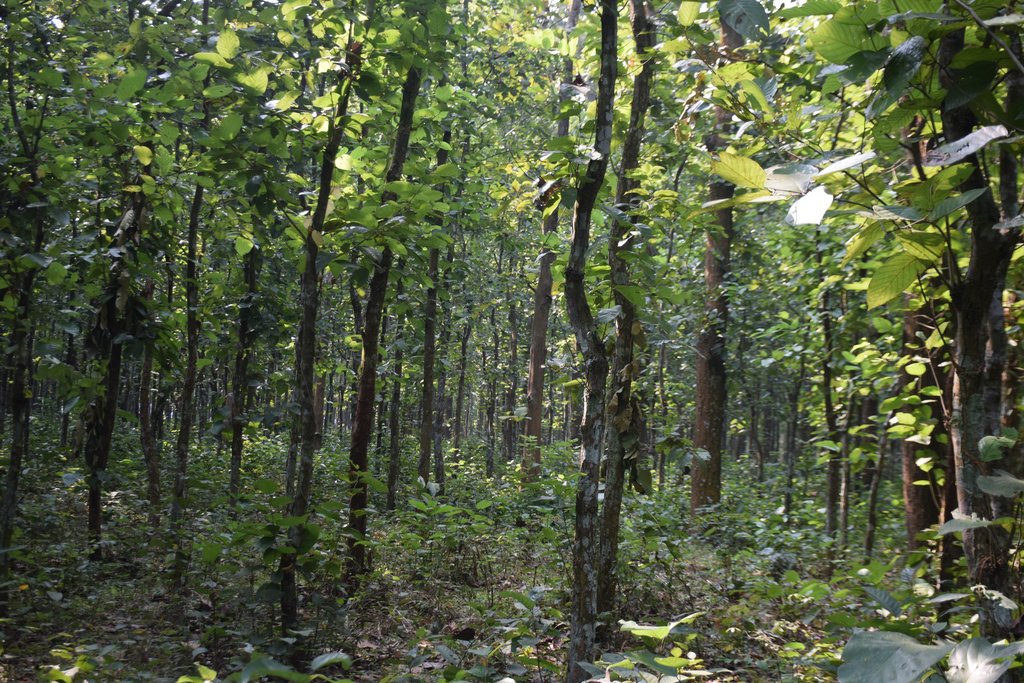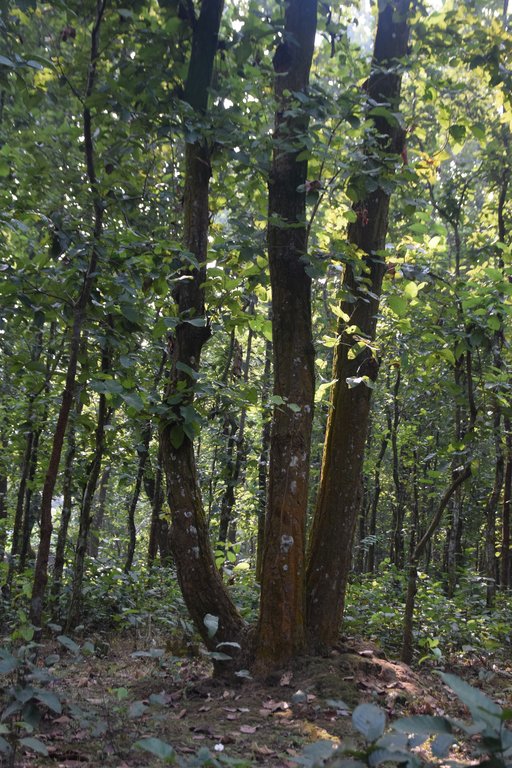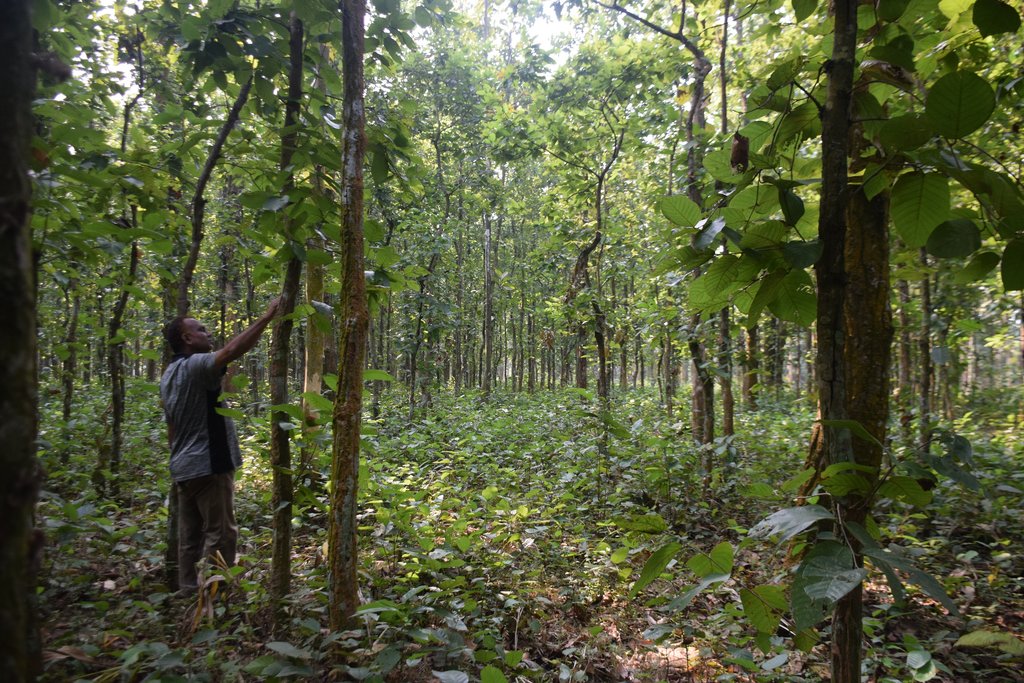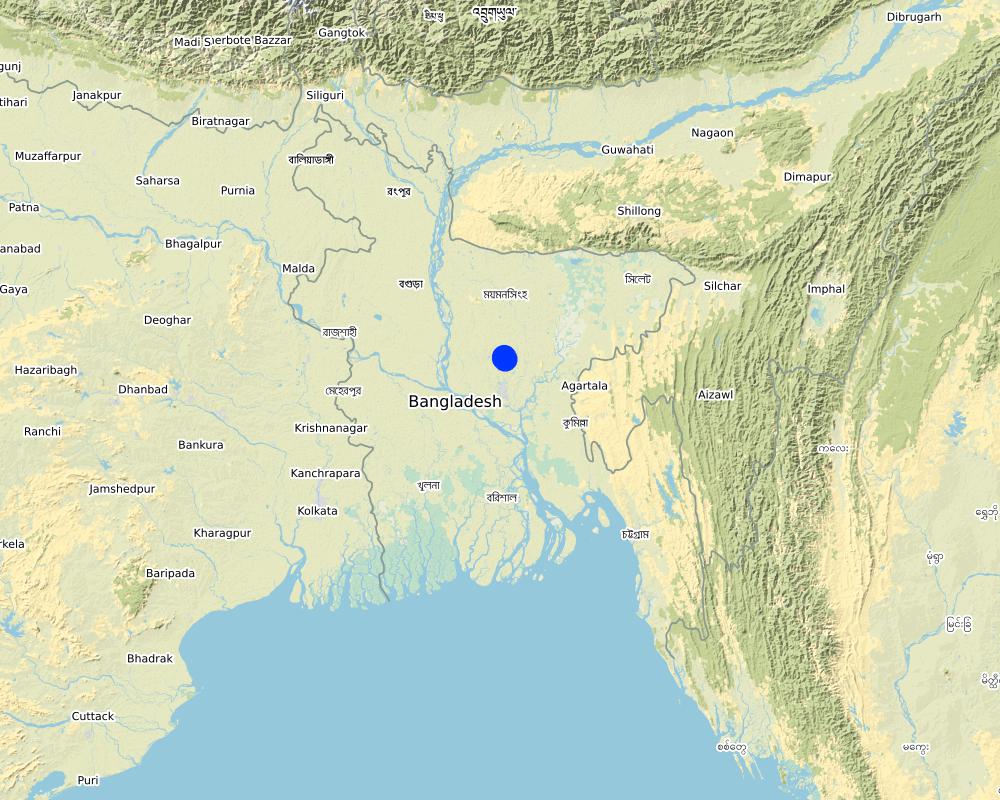Coppice management of Sal (Shorea robusta) forest [Bangladesh]
- Creation:
- Update:
- Compiler: Fazlay Arafat
- Editor: –
- Reviewers: Rima Mekdaschi Studer, Ursula Gaemperli
Sal bon bebosthapona
technologies_4830 - Bangladesh
View sections
Expand all Collapse all1. General information
1.2 Contact details of resource persons and institutions involved in the assessment and documentation of the Technology
Key resource person(s)
SLM specialist:
Mohammed Nur
Bangladesh Forest Department
Bangladesh
land user:
Abedin Md. Joynal
Bangladesh
land user:
Rahman Md. Mojibur
Bangladesh
1.3 Conditions regarding the use of data documented through WOCAT
The compiler and key resource person(s) accept the conditions regarding the use of data documented through WOCAT:
Yes
1.4 Declaration on sustainability of the described Technology
Is the Technology described here problematic with regard to land degradation, so that it cannot be declared a sustainable land management technology?
No
2. Description of the SLM Technology
2.1 Short description of the Technology
Definition of the Technology:
The coppice management of Sal (Shorea robusta) tree is a forest management practice to regain the natural forest resources in central and northern parts of Bangladesh.
2.2 Detailed description of the Technology
Description:
Sal forests have a fairly wide and interrupted distribution in the drier central and northern parts of the country. These tropical moist deciduous forests are popularly known as Sal forest as the predominant species is Sal (Shorea robusta). The importance of Sal forests lies in the fact that these are the only natural forest resources of the central and northern parts of Bangladesh where the majority of the country’s population lives. Historically, the agrarian rural people around the forests have been heavily dependent on Sal forests for their livelihood. Until the beginning of the 20th century, Sal forests existed as a large continuous belt with rich biological resources but increasing pressure from population growth has been placed on them ever since. Most of the Sal forests have either become degraded in quality or reduces by conversion to agricultural land.
The Forest Department introduced coppice management with natural regeneration in Sal forest that have a rotation of 20-30 years to regain the forest structure and biomass. Coppicing is a traditional method of forest management, which exploits the capacity of tree species to put out new shoots from their stump or roots if cut down. Due to the fact that shoots perform better than seedlings, because they obtain water, nutrients and carbohydrates from a well-developed root system of the parent tree, they are more resilient to human disturbances that affect tree growth and survival. As new growth emerges after a number of years, the coppiced tree is harvested, and the cycle begins again. Therefore, coppicing is considered an efficient mechanism by which trees regain above-ground biomass immediately after disturbance.
The Gazipur Sal forest is located in lowland plain areas of the central parts of Bangladesh. The average temperature in Gazipur is 25.8 °C and the annual rainfall is 2036 mm. The area is densely populated with a population density of 2,505 per square km. The dominant land use is still agriculture, but industrialization rate is higher in the area as it is only 25km away from capital Dhaka. The Sal forest area is managed by Bangladesh Forest division. Co-management approach is introduced in some buffer areas for the coppice management of Shorea robusta with a profit-sharing ratio of 65:25 between forest department and community beneficiaries. The rest of 10% money allocated for further tree farming activities.
No new planting of Sal seedlings is necessary for this practice. In the first year a relatively poor-quality Sal stand of Gazipur site were selected where coppice regeneration took place from stumps. Then, the multiple shoots regenerated from the stump were singled to three best shoots per stump and the rest were harvested. These three shoots were maintained in the following years and new shoots were removed if there were any. In addition, regular weeding was needed to maintain the technology. Local community people engaged to the maintenance and surveillance activities through co-management modalities and they will get their profit share after harvesting of the mature stand.
Where the density of Sal stumps is between 200-400 stems/ha, coppice management potentially protects and promotes the growth of new Sal seedling and other natural species in open areas. The native species regeneration under coppice management helps protect biodiversity value in a cost-effective manner. Coppice Sal Forests have the capacity to regenerate a rich variety of Non-Timber Forest Products (NTFPs). The major NTFPs collected by the co-management beneficiaries include fuelwood, dry leaves for fuel, and medicinal plants. Apart from this, they also collect mushroom, tuber crops, wild fruits, cane, honey and resin from coppice forests. As the area is under permanently protected area the beneficiaries cannot harvest any timber from the stand.
As the artificial regeneration of Sal is difficult, the sustainable forest management can be ensured through coppice management of Sal. In Gazipur, the depleted Sal forest are now slowly regaining its health and habitats for wildlife are improving as well. These forests, which historically were seen as timber sources, are now managed for multiple products through coppice management. The forest now supports alternate income for community people and also playing important role for ecological balance of this region.
2.3 Photos of the Technology
2.5 Country/ region/ locations where the Technology has been applied and which are covered by this assessment
Country:
Bangladesh
Region/ State/ Province:
Dhaka division
Further specification of location:
Gazipur
Specify the spread of the Technology:
- evenly spread over an area
If precise area is not known, indicate approximate area covered:
- 10-100 km2
Is/are the technology site(s) located in a permanently protected area?
Yes
If yes, specify:
The Gazipur Sal forest is located in a permanent protected area where local communities cannot collect any timber other than fuel wood and NTFP
Map
×2.6 Date of implementation
If precise year is not known, indicate approximate date:
- 10-50 years ago
2.7 Introduction of the Technology
Specify how the Technology was introduced:
- as part of a traditional system (> 50 years)
3. Classification of the SLM Technology
3.1 Main purpose(s) of the Technology
- improve production
- reduce, prevent, restore land degradation
- conserve ecosystem
- create beneficial economic impact
- create beneficial social impact
3.2 Current land use type(s) where the Technology is applied
Land use mixed within the same land unit:
No

Forest/ woodlands
- (Semi-)natural forests/ woodlands
(Semi-)natural forests/ woodlands: Specify management type:
- Dead wood/ prunings removal
Type of (semi-)natural forest:
- tropical moist deciduous forest natural vegetation
- Shorea robusta; Terminalia bellirica; Phyllanthus emblica; Albizia saman
Are the trees specified above deciduous or evergreen?
- mixed deciduous/ evergreen
Products and services:
- Timber
- Fuelwood
- Fruits and nuts
- Other forest products
- Nature conservation/ protection
- Recreation/ tourism
3.3 Has land use changed due to the implementation of the Technology?
Has land use changed due to the implementation of the Technology?
- No (Continue with question 3.4)
Comments:
The original Sal forest stand faced rapid reduction through over-exploitation, deforestation, excessive leaf-litter collection, encroachment, indiscriminate collection of specific economically important plant species (i.e medicinal, fodder etc), and other form of human interference. This was degraded forest with some scatter trees.
3.4 Water supply
Water supply for the land on which the Technology is applied:
- rainfed
3.5 SLM group to which the Technology belongs
- natural and semi-natural forest management
- forest plantation management
- improved ground/ vegetation cover
3.6 SLM measures comprising the Technology

vegetative measures
- V1: Tree and shrub cover

management measures
- M2: Change of management/ intensity level
3.7 Main types of land degradation addressed by the Technology

soil erosion by water
- Wt: loss of topsoil/ surface erosion

soil erosion by wind
- Et: loss of topsoil

biological degradation
- Bc: reduction of vegetation cover
- Bh: loss of habitats
- Bq: quantity/ biomass decline
- Bs: quality and species composition/ diversity decline
- Bl: loss of soil life
3.8 Prevention, reduction, or restoration of land degradation
Specify the goal of the Technology with regard to land degradation:
- reduce land degradation
4. Technical specifications, implementation activities, inputs, and costs
4.1 Technical drawing of the Technology
Technical specifications (related to technical drawing):
The left hand of the picture represents a depleted Sal forest where only few trees remain and multiple shoots regenerated from the stumps of chopped down Sal trees. The right hand of the picture shows the coppice management in the depleted forest stand. From the regenerated multiple shoots of only one to three best shoots per stump are allowed to grow and other shoots removed. These three shoots were maintained in the following years and new shoots were removed if there were any.
Author:
Nazrin Sultana
Date:
20/05/2019
4.2 General information regarding the calculation of inputs and costs
Specify how costs and inputs were calculated:
- per Technology area
Indicate size and area unit:
1 ha
If using a local area unit, indicate conversion factor to one hectare (e.g. 1 ha = 2.47 acres): 1 ha =:
2.47 acres
other/ national currency (specify):
BDT
If relevant, indicate exchange rate from USD to local currency (e.g. 1 USD = 79.9 Brazilian Real): 1 USD =:
84.0
Indicate average wage cost of hired labour per day:
500 BDT
4.3 Establishment activities
| Activity | Timing (season) | |
|---|---|---|
| 1. | Site preparation (prepare plantation site map with GPS, jungle cutting, debris collection) | June-July |
| 2. | Thinning (removal of unwanted shoots from stumps) | June-July |
| 3. | Application of fertilizer (compost) | July |
4.4 Costs and inputs needed for establishment
| Specify input | Unit | Quantity | Costs per Unit | Total costs per input | % of costs borne by land users | |
|---|---|---|---|---|---|---|
| Labour | Site preparation (prepare plantation site map with GPS, jungle cutting, debris collection) | person-days | 5.0 | 500.0 | 2500.0 | 100.0 |
| Labour | Thinning (removal of unwanted shoots from stumps) | person-days | 12.0 | 500.0 | 6000.0 | 100.0 |
| Labour | Application of fertilizer | person-days | 5.0 | 500.0 | 2500.0 | 100.0 |
| Equipment | Spade, saw, bucket, knife, etc. | lump sum | 1.0 | 2000.0 | 2000.0 | 100.0 |
| Fertilizers and biocides | Compost fertilizer | kg | 2000.0 | 4.0 | 8000.0 | 100.0 |
| Total costs for establishment of the Technology | 21000.0 | |||||
| Total costs for establishment of the Technology in USD | 250.0 | |||||
Comments:
Bangladesh Forest Department is the land owner and bear the cost of this practice
4.5 Maintenance/ recurrent activities
| Activity | Timing/ frequency | |
|---|---|---|
| 1. | 1st year weeding | 3 times |
| 2. | 2nd year weeding | 3 times |
| 3. | 3rd year weeding | 2 times |
| 4. | 4th year weeding | 1 time |
4.6 Costs and inputs needed for maintenance/ recurrent activities (per year)
| Specify input | Unit | Quantity | Costs per Unit | Total costs per input | % of costs borne by land users | |
|---|---|---|---|---|---|---|
| Labour | 1st year weeding | person-days | 12.0 | 500.0 | 6000.0 | 100.0 |
| Labour | 2nd year weeding | person-days | 12.0 | 500.0 | 6000.0 | 100.0 |
| Labour | 3rd year weeding | person-days | 8.0 | 500.0 | 4000.0 | 100.0 |
| Labour | 4th year weeding | person-days | 4.0 | 500.0 | 2000.0 | 100.0 |
| Equipment | Spade, saw, bucket, knife, etc. | Lump-sum | 1.0 | 2000.0 | 2000.0 | 100.0 |
| Total costs for maintenance of the Technology | 20000.0 | |||||
| Total costs for maintenance of the Technology in USD | 238.1 | |||||
4.7 Most important factors affecting the costs
Describe the most determinate factors affecting the costs:
Labor cost
5. Natural and human environment
5.1 Climate
Annual rainfall
- < 250 mm
- 251-500 mm
- 501-750 mm
- 751-1,000 mm
- 1,001-1,500 mm
- 1,501-2,000 mm
- 2,001-3,000 mm
- 3,001-4,000 mm
- > 4,000 mm
Agro-climatic zone
- sub-humid
5.2 Topography
Slopes on average:
- flat (0-2%)
- gentle (3-5%)
- moderate (6-10%)
- rolling (11-15%)
- hilly (16-30%)
- steep (31-60%)
- very steep (>60%)
Landforms:
- plateau/plains
- ridges
- mountain slopes
- hill slopes
- footslopes
- valley floors
Altitudinal zone:
- 0-100 m a.s.l.
- 101-500 m a.s.l.
- 501-1,000 m a.s.l.
- 1,001-1,500 m a.s.l.
- 1,501-2,000 m a.s.l.
- 2,001-2,500 m a.s.l.
- 2,501-3,000 m a.s.l.
- 3,001-4,000 m a.s.l.
- > 4,000 m a.s.l.
Indicate if the Technology is specifically applied in:
- not relevant
5.3 Soils
Soil depth on average:
- very shallow (0-20 cm)
- shallow (21-50 cm)
- moderately deep (51-80 cm)
- deep (81-120 cm)
- very deep (> 120 cm)
Soil texture (topsoil):
- fine/ heavy (clay)
Soil texture (> 20 cm below surface):
- fine/ heavy (clay)
Topsoil organic matter:
- high (>3%)
5.4 Water availability and quality
Ground water table:
5-50 m
Availability of surface water:
medium
Water quality (untreated):
for agricultural use only (irrigation)
Water quality refers to:
surface water
Is water salinity a problem?
No
Is flooding of the area occurring?
No
5.5 Biodiversity
Species diversity:
- medium
Habitat diversity:
- medium
5.6 Characteristics of land users applying the Technology
Sedentary or nomadic:
- Sedentary
Market orientation of production system:
- mixed (subsistence/ commercial)
Off-farm income:
- 10-50% of all income
Relative level of wealth:
- average
Individuals or groups:
- employee (company, government)
Level of mechanization:
- manual work
Gender:
- women
- men
Age of land users:
- youth
- middle-aged
- elderly
5.7 Average area of land used by land users applying the Technology
- < 0.5 ha
- 0.5-1 ha
- 1-2 ha
- 2-5 ha
- 5-15 ha
- 15-50 ha
- 50-100 ha
- 100-500 ha
- 500-1,000 ha
- 1,000-10,000 ha
- > 10,000 ha
Is this considered small-, medium- or large-scale (referring to local context)?
- medium-scale
5.8 Land ownership, land use rights, and water use rights
Land ownership:
- state
Land use rights:
- communal (organized)
Water use rights:
- open access (unorganized)
Are land use rights based on a traditional legal system?
No
Specify:
Participatory forest management in coppice Sal forest with local commuities
5.9 Access to services and infrastructure
health:
- poor
- moderate
- good
education:
- poor
- moderate
- good
technical assistance:
- poor
- moderate
- good
employment (e.g. off-farm):
- poor
- moderate
- good
markets:
- poor
- moderate
- good
energy:
- poor
- moderate
- good
roads and transport:
- poor
- moderate
- good
drinking water and sanitation:
- poor
- moderate
- good
financial services:
- poor
- moderate
- good
6. Impacts and concluding statements
6.1 On-site impacts the Technology has shown
Socio-economic impacts
Production
wood production
forest/ woodland quality
non-wood forest production
risk of production failure
product diversity
Comments/ specify:
Some agroforestry products also derived from the practice of local communities
Income and costs
diversity of income sources
Socio-cultural impacts
land use/ water rights
Comments/ specify:
re-establishment of Sal forest through coppice management with involving local community allowed them to collect NTFP from the forest
cultural opportunities
recreational opportunities
Comments/ specify:
Ecotourism has benn promoted in the area
community institutions
Comments/ specify:
Through co-management of Sal forest the local community institutions strengthened
SLM/ land degradation knowledge
Comments/ specify:
The scattered degraded forest is now managed in a sustainable manner
conflict mitigation
Comments/ specify:
Conflict on forest land use has been reduced due to co-management
situation of socially and economically disadvantaged groups
Comments/ specify:
the extreme poor people who were depended on forest now are member of the co-management group under the profit sharing approach
Ecological impacts
Soil
soil moisture
soil cover
soil loss
soil accumulation
soil compaction
nutrient cycling/ recharge
soil organic matter/ below ground C
Biodiversity: vegetation, animals
Vegetation cover
biomass/ above ground C
plant diversity
beneficial species
habitat diversity
Climate and disaster risk reduction
emission of carbon and greenhouse gases
wind velocity
micro-climate
6.2 Off-site impacts the Technology has shown
water availability
Comments/ specify:
groundwater aquifer recharges due to presence of forest canopy cover
buffering/ filtering capacity
wind transported sediments
impact of greenhouse gases
6.3 Exposure and sensitivity of the Technology to gradual climate change and climate-related extremes/ disasters (as perceived by land users)
Gradual climate change
Gradual climate change
| Season | increase or decrease | How does the Technology cope with it? | |
|---|---|---|---|
| annual temperature | increase | well | |
| seasonal temperature | summer | increase | well |
| annual rainfall | decrease | well | |
| seasonal rainfall | wet/ rainy season | increase | well |
Climate-related extremes (disasters)
Meteorological disasters
| How does the Technology cope with it? | |
|---|---|
| local rainstorm | well |
| local thunderstorm | well |
Climatological disasters
| How does the Technology cope with it? | |
|---|---|
| drought | moderately |
6.4 Cost-benefit analysis
How do the benefits compare with the establishment costs (from land users’ perspective)?
Short-term returns:
slightly negative
Long-term returns:
very positive
How do the benefits compare with the maintenance/ recurrent costs (from land users' perspective)?
Short-term returns:
slightly negative
Long-term returns:
very positive
6.5 Adoption of the Technology
- > 50%
Of all those who have adopted the Technology, how many did so spontaneously, i.e. without receiving any material incentives/ payments?
- 91-100%
Comments:
Forest department adopted the technology and replicate it in other Sal forest area with co-management approach
6.6 Adaptation
Has the Technology been modified recently to adapt to changing conditions?
No
6.7 Strengths/ advantages/ opportunities of the Technology
| Strengths/ advantages/ opportunities in the land user’s view |
|---|
| Establishment and maintenance costs arelow. |
| Artificial regeneration of Sal is difficult. Through coppice management forest coverage can be ensured for long period. |
| The population of the community can cover their fuel needs from the Sal forests. |
| Strengths/ advantages/ opportunities in the compiler’s or other key resource person’s view |
|---|
| Increases the soil fertility of the degraded land through nutrient cycle. |
| Biodiversity conservation through habitat improvement. |
| Increase of carbon sequestration. |
6.8 Weaknesses/ disadvantages/ risks of the Technology and ways of overcoming them
| Weaknesses/ disadvantages/ risks in the land user’s view | How can they be overcome? |
|---|---|
| Protection from illicit felling of Sal is difficult. | Community people need to be engage in patrolling |
| Occurrence of fire in dry seasons hampered Sal coppice stand |
| Weaknesses/ disadvantages/ risks in the compiler’s or other key resource person’s view | How can they be overcome? |
|---|---|
| Timber yield from coppice stand of Sal is inferior in comparison with original stand of Sal. | Vacancy filling can be done with high value timber species |
7. References and links
7.1 Methods/ sources of information
- field visits, field surveys
Number of informants: 5 persons
- interviews with land users
Number of informants: 4 persons
- interviews with SLM specialists/ experts
Number of informants: 2 persons
- compilation from reports and other existing documentation
Number of scientific articles: 3
When were the data compiled (in the field)?
20/11/2018
7.2 References to available publications
Title, author, year, ISBN:
Islam KK, Sato N, 2012. Deforestation, land conversion and illegal logging in Bangladesh: the case of the Sal (Shorea robusta) forests. iForest 5: 171-178 [online 2012-06-25]
Available from where? Costs?
http://www.sisef.it/iforest/contents? id=ifor0578-005
Title, author, year, ISBN:
Hossain, M.K. 2015. Silviculture of Plantaion Trees of Bangladesh, ISBN:978-984-33-9767-6
Available from where? Costs?
Arannayk Foundation, Dhaka, Bangladesh. US$ 15
7.3 Links to relevant online information
Title/ description:
Joint Forest Management and Adaptation of Sal (Shorea robusta) and Its Flexibility in Wide Range of Ecological factors in Forest Gardens
URL:
http://ajast.net/data/uploads/5022.pdf
7.4 General comments
The questionnaire covers all the aspect of the practice
Links and modules
Expand all Collapse allLinks
No links
Modules
No modules


